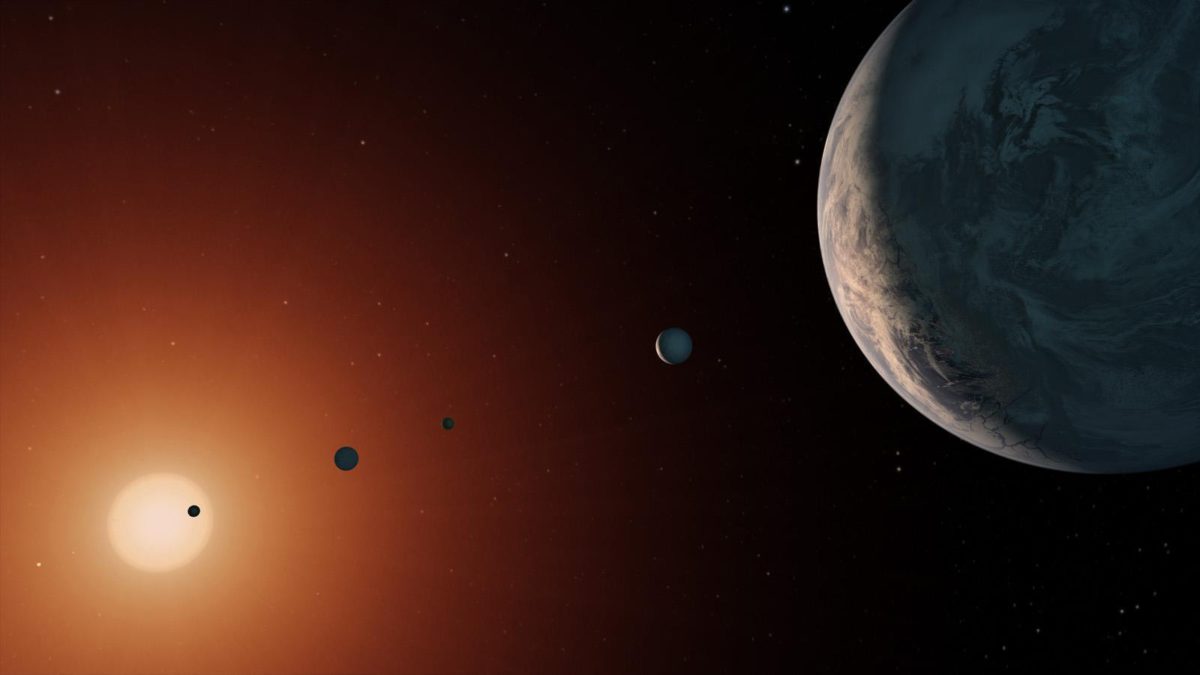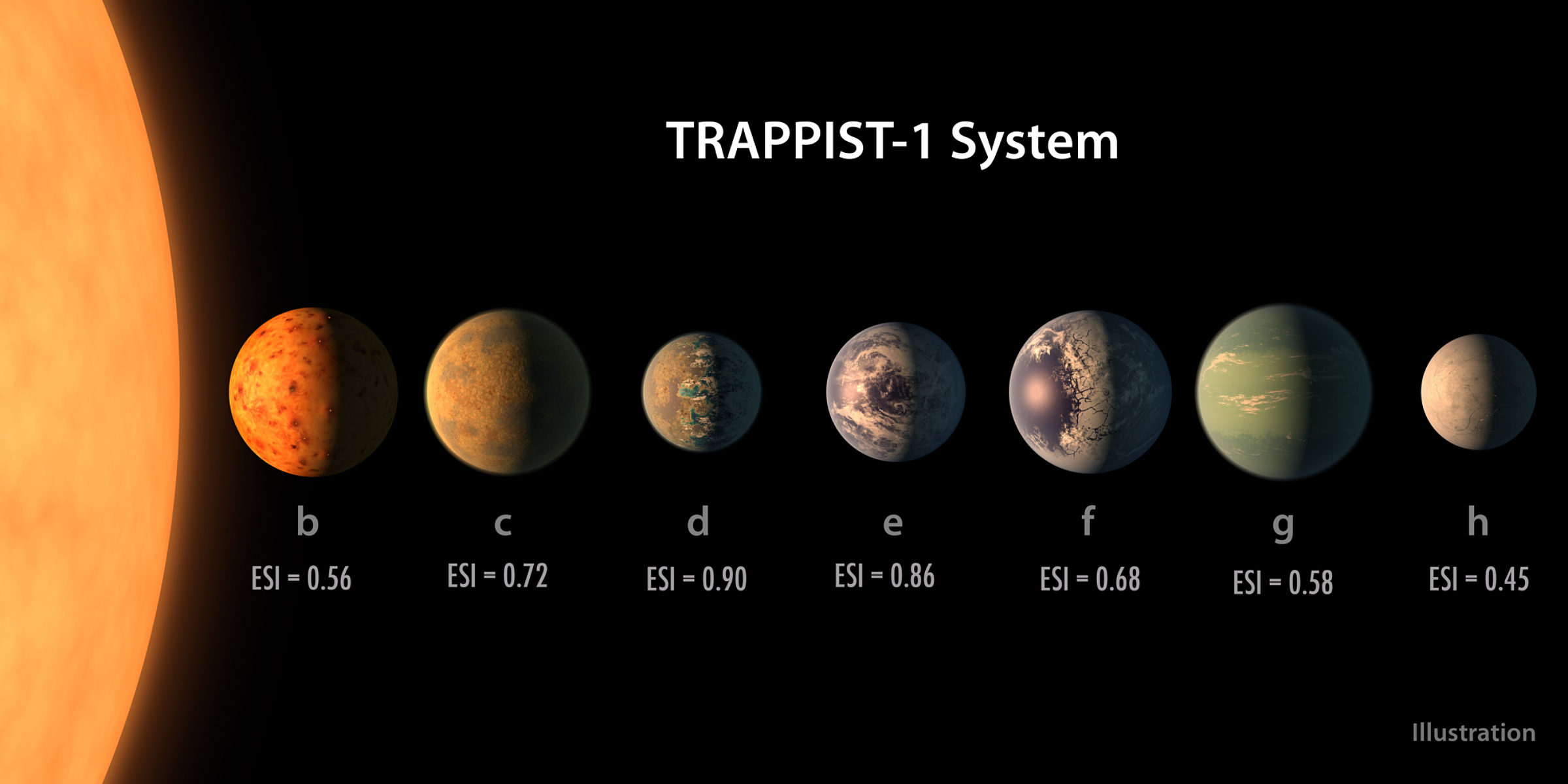William Balmer • Jun 09, 2022
What might JWST reveal about TRAPPIST-1?
NASA’s James Webb Space Telescope (JWST) is poised to revolutionize our understanding of exoplanets. In its first year, it’ll spend a significant chunk of time studying a mysterious single star system.
According to the JWST Science Policy Group, over the next year, JWST will spend a full quarter of its time studying exoplanets, and 8.2% of its exoplanet observations staring at the distant star TRAPPIST-1. Claims are flying about discovering everything from thermal emission, signatures of water, and even signs of life on the planets orbiting TRAPPIST-1.
We spoke with the scientists leading the first observations of this unique planetary system with JWST to understand what mysteries their observations will help unlock, as well as why so much time has been devoted to TRAPPIST-1. What can this tiny system teach us about rocky planets and potentially, life in the universe?
What is TRAPPIST-1?
TRAPPIST-1 is an ultracool M-dwarf, the smallest class of star. Discovered in 2016 and 2017 by the Transiting Planets and Planetesimals Small Telescope (TRAPPIST), seven rocky planets — TRAPPIST-1b, c, d, e, f, g, and h — closely orbit their diminutive host star.
There are some qualities that make TRAPPIST-1 particularly appealing to researchers. It’s relatively nearby, with a temperature of about 2,400 degrees Celcius (roughly 4,350 degrees Fahrenheit), and with a mass and radius many times smaller than the Sun.
All seven TRAPPIST planets orbit their host very closely. Even the most distant — TRAPPIST-1h — orbits at only 0.062 astronomical units (AU), six times closer than Mercury is to the Sun. They block out a larger fraction of TRAPPIST-1’s light than more widely separated planets.
“TRAPPIST-1’s radius is only 12% that of the Sun, so it's just a little bigger than Jupiter,” explained Olivia Lim, PhD student at the Université de Montréal and principal investigator of a JWST program surveying four of the seven TRAPPIST-1 planets. “This is a plus because for a given planet radius, the transit signal is easier to detect for a smaller star.”

Demystifying the habitable zone
Because TRAPPIST-1 is so cool, the “habitable zone” where liquid water could condense on an Earth-like planet’s surface, encompasses the close-in orbits of planets d, e, f, and g. This means that if these planets are similar to our own, they could have oceans of water.
Testing the properties of planets in the habitable zone can help astronomers understand how different conditions affect habitability. The strength of solar winds, the density of a planet, the prevalence of large moons, the orientation of the planet’s orbit, and the planet’s rotation (or apparent lack thereof) could all be key factors for habitability. A simple criterion like the habitable zone could prove to be a good rule of thumb or more trouble than it’s worth.
“This system provides an opportunity to test the concept of the habitable zone outside of the Solar System,” said Jacob Lustig-Yaeger, post-doctoral fellow at the Johns Hopkins University Applied Physics Laboratory and co-investigator of a JWST program that will observe TRAPPIST-1h, among other rocky planets.
“TRAPPIST-1 is so different from the Sun, and the planets orbit so close to it, that it’s likely that there will be many surprises in our study of this system, and our efforts to understand these surprises will push forward the boundaries of planetary science.”
Rocky planet atmospheres
A major theme of JWST’s upcoming TRAPPIST-1 observations is “atmospheric reconnaissance” — testing whether an atmosphere even exists around the TRAPPIST-1 planets. Having an atmosphere is a prerequisite for life as we know it, and atmospheres can carry molecules called biosignatures. These observational markers of molecules act as signposts toward life.
“In recent years astronomers spent significant telescope time to try and detect atmospheres on Earth-sized exoplanets,” said Daniel Koll, assistant professor at Peking University and co-investigator of a JWST program studying TRAPPIST-1c. “Unfortunately these efforts couldn't tell whether the TRAPPIST-1 planets have very thick and cloudy atmospheres or no atmosphere whatsoever.”
Since its discovery in 2017, scientists have used the Hubble Space Telescope to attempt to detect atmospheres around all seven of the TRAPPIST-1 planets. They were able to say for certain that the small planets did not have large, puffy, hydrogen-rich atmospheres. But they were unable to convincingly detect smaller, thinner, atmospheres, like our own.
All that said, JWST can detect subtleties that Hubble can’t. For one thing, it has a much larger mirror than Hubble — three times the diameter and about six times the collecting area. It also operates in the mid-infrared, where cool stars like TRAPPIST-1 emit their light.
JWST is also on a more stable orbit: rather than whipping around the Earth once every 97 minutes like Hubble, JWST sits out at L2, a stable point in space where Earth’s gravitational influence cancels out the Sun’s tug. That allows JWST to continuously view its targets for hours at a time, important for transit events.
In JWST’s first year, astronomers will check each planet in the TRAPPIST-1 system for signs of an atmosphere.
“Our goal,” said Lim, “is to tell whether the planets TRAPPIST-1b, c, g, and h have an atmosphere or not, and to do that, we will try to detect features of molecules such as carbon dioxide, water, and ozone in the transit spectra of those planets.”
Detecting atmospheres around the TRAPPIST-1 planets would have major implications for the study of exoplanets. Some astronomers speculate that rocky planets so close to their host stars might have their atmospheres removed by solar flares. The properties of these atmospheres might be dramatically altered by tidal locking, a gravitational process affecting close-in planets that keeps one hemisphere of the planet always facing the star.
Geological and biological processes can cycle carbon, nitrogen, and oxygen through rocky planet atmospheres, leading to different compositions depending on the prevalence of oceans, plate tectonics, and even life. But studying all these fascinating topics requires detecting an atmosphere first.

Water and alien life
News surrounding the release of JWST science results is brimming with anticipation. Many theoretical results have discussed the potential for JWST to study liquid water on the TRAPPIST planets or even biosignatures.
Will JWST find signs of life? The astronomers we spoke to were cautiously optimistic — emphasis on “cautiously.”
“Our observations likely won't be able to reveal biosignatures, but I believe they are a good first step,” said Lim. “The reality is that we don't know what is on those planets. We can only speculate based on a very small sample of atmospheric models that are likely not representative.”
The public shouldn’t expect any announcements of biosignature detection in the first year. At the very least, it should treat such claims with adequate skepticism. As Lustig-Yaeger said: “detecting biosignatures is the long game.”
For example, there are many abiotic processes that can mimic biosignatures. Excess oxygen can be created by photosynthesis from living plants, but could also be generated by photochemical processes, where light breaks apart oxygen-bearing compounds. Molecular oxygen, a potential biosignature due to its prevalence in the Earth’s atmosphere, has fallen under heavy scrutiny lately because scientists have shown it can be produced in many different ways. These photochemical processes could be more prevalent for planets around smaller stars, like TRAPPIST-1.
“It is our responsibility to explain clearly what we found,” said Lim. “For example, that could mean detecting a water feature in the spectrum of one of the TRAPPIST-1 planets, describing how confident we are in that finding, and what it implies. Water does not imply aliens.”
That doesn’t mean these observations of TRAPPIST-1 won’t change history. After all, studying terrestrial exoplanet atmospheres is a multi-step process, with the eventual goal of detecting worlds like our own.
Astronomers are still confident we can expect major results, but it all comes down to one small, nearby star.
“My hope is that JWST will provide firm detections of numerous terrestrial exoplanet atmospheres along with a census of a few key molecules,” said Lustig-Yaeger. “In many ways, the TRAPPIST-1 system is the reason I think that this could be achieved with JWST.”
The Time is Now.
As a Planetary Defender, you’re part of our mission to decrease the risk of Earth being hit by an asteroid or comet.
Donate Today

 Explore Worlds
Explore Worlds Find Life
Find Life Defend Earth
Defend Earth

